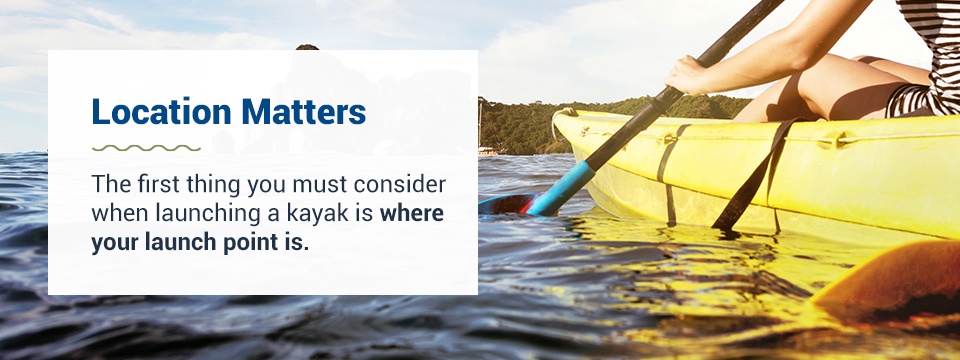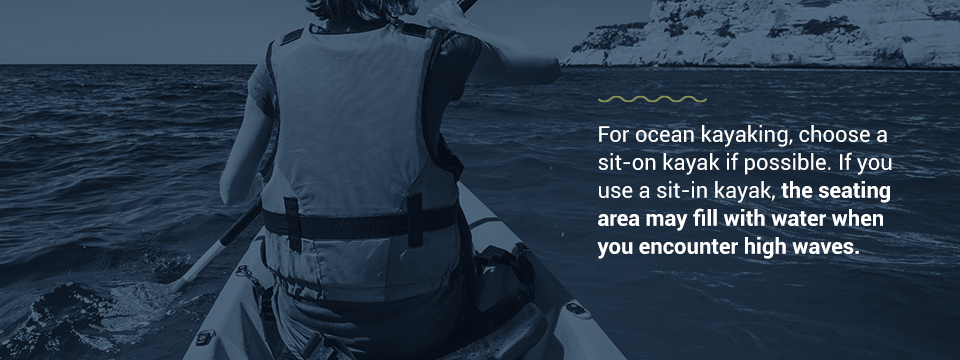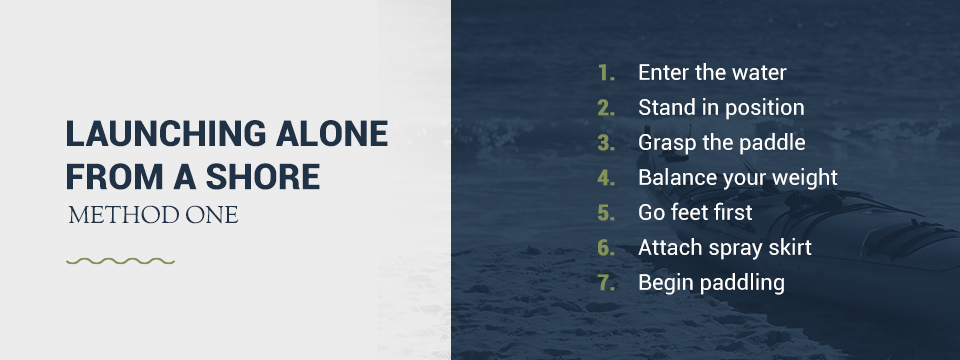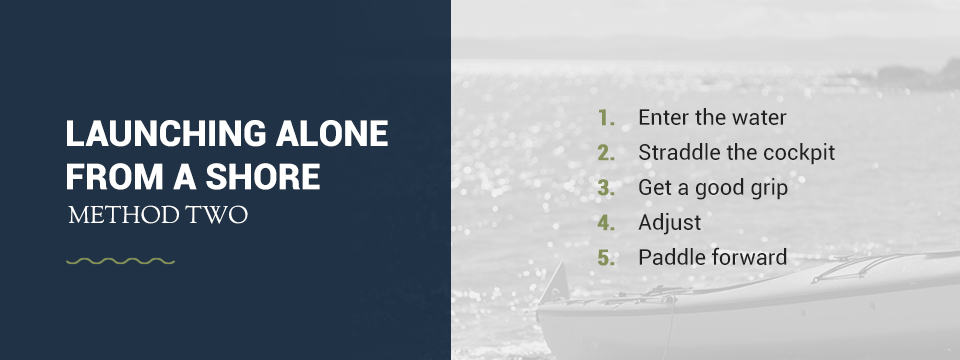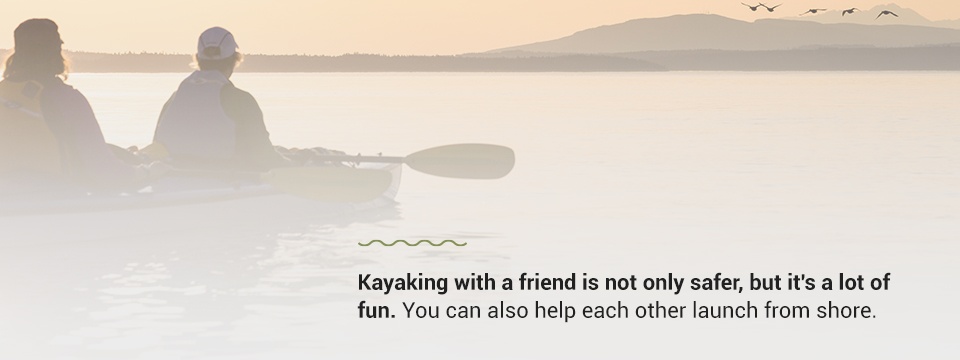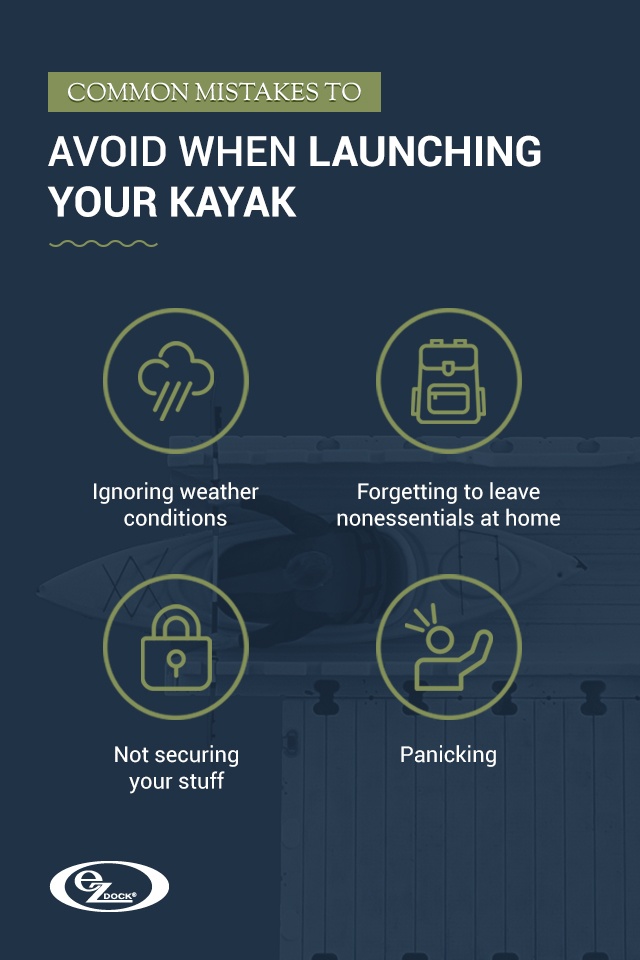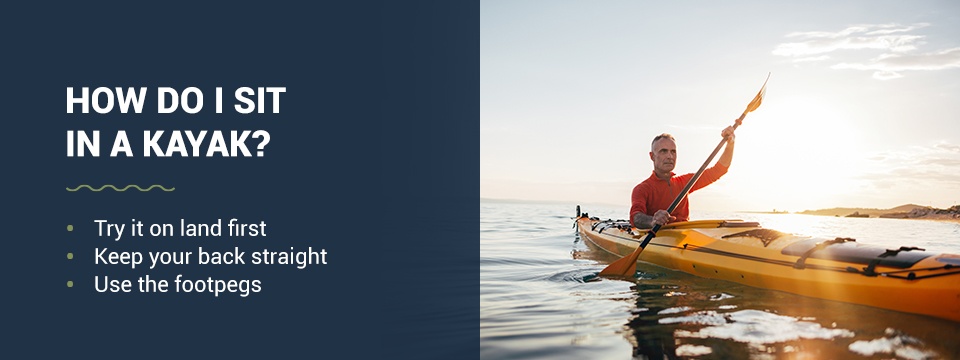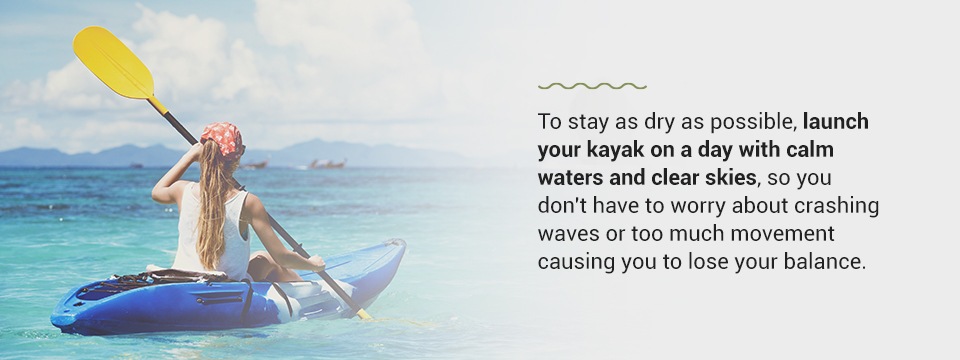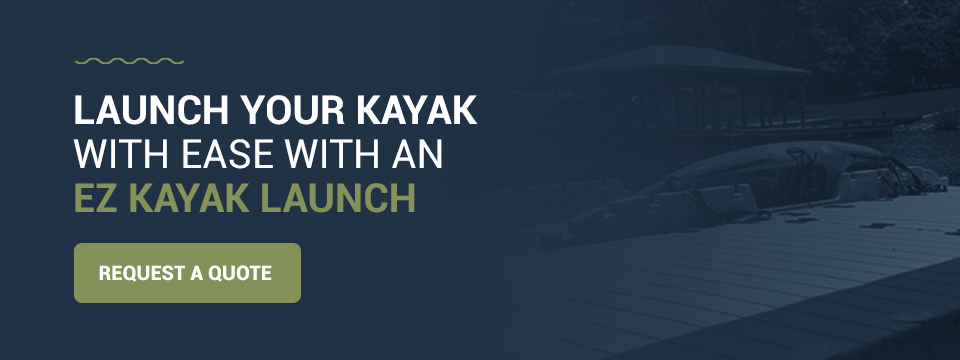Filters
How to Launch a Kayak: Here’s What You Need to Know
Nothing beats spending a sunny day kayaking on the open water, but before you can begin your on-the-water adventure, you need to master the skill of launching your kayak. This skill can be tricky for beginners, and it might take a few tries to get it right.
To help you conquer the learning curve, we’ve compiled a guide for everything you need to know about launching a kayak. You’ll learn why your location matters and how to stay safe in different water conditions, how to enter and exit your vessel without tipping, and common mistakes you should avoid. Then, we’ll wrap things up by answering a few of the most commonly asked questions about EZ Launch® Residentialing.
Read the full article or jump to a specific section:
- Location Matters
- Launching Alone From a Shore: Method One
- Launching Alone Froma Shore: Method Two
- Launching From Shore with a Partner
- Launching a Kayak from a Dock
- Exiting the Kayak
- Common Mistakes to Avoid When Launching Your Kayak
- Launching a Kayak: Frequently Asked Questions
- Launch Your Kayak Witch Ease With an EZ Launch® Residential
Location Matters
The first thing you must consider when launching a kayak is where your launch point is. Kayaking in the ocean is vastly different from kayaking in a freshwater river or lake. Additionally, launching from a dock is different than launching directly from the shore, beach or ramp.
Ocean Surf
One of the most important things to learn before kayaking in the ocean is how to launch in a surf zone. Kayaking in the sea — especially in rough waves — is not ideal for beginners, as some situations may be dangerous if you’re unfamiliar with navigating the water and controlling your boat. For your safety, always remember to wear a life jacket. Because waves can easily wash gear out of your kayak, bring as little equipment as possible. Consider adding a spray skirt to your kayak once you’re safely sitting inside the cockpit, as it will help keep you and your cockpit dry when breaking through waves.
Keep in mind that not all kayaks feature the same construction. For ocean kayaking, choose a sit-on kayak if possible. If you use a sit-in kayak, the seating area may fill with water when you encounter high waves. Never kayak in the ocean alone, as water conditions can change rapidly.
Whether you’re taking advantage of the surf to catch some fish from your kayak or are craving a wavy ride, here’s what you need to know about launching a kayak in the ocean.
- Launch from a gradually sloping spot: The secret to launching a kayak from shore is to find a place that gradually slopes into the water, rather than a steep drop-off. That way, you can ease both yourself and your kayak into the water, rather than trying to stay afloat while boarding. A boat or kayak ramp is ideal, but you can use a sloping section of shoreline. The shoreline will also give your kayak traction, making it easier to balance as you get in.
- Keep track of the waves: Walk the slope into the water until you’re about knee-deep. Keep an eye on the waves while you do this — depending on the type of wave, they can be anywhere from 0.2 to 30 seconds apart.
- Face the surf: Point the nose of your kayak directly toward the surf. Wait until you see a break in the waves, then jump into your kayak as quickly as possible before the next set of waves hits.
- Paddle into waves: Once you’re in your kayak, paddle directly into the waves using hard, fast strokes, so you can break through them as they come.
River and Lake Shores
Although there is still plenty of movement on lakes and rivers, you don’t have to worry about strong tides or crashing waves like you would if launching on the ocean. It’s always easier to launch a kayak with someone else’s help, so they can hold it stable for you. If no partner is available or you aren’t sure how to get in a sit-in kayak, don’t worry! You still have plenty of options available.
Launching Alone From a Shore: Method One
One technique you can try involves using your paddle to balance as you board your kayak and then using your paddle, fist and hips to propel the vessel forward.
Here’s how to launch a kayak from a beach, ramp or shoreline.
- Enter the water: Carefully move your kayak toward the water’s edge, avoiding any rocks or debris that could scratch or tangle around your kayak. The nose of your vessel should extend far enough into the water that the cockpit area is floating, with the end of the kayak still on the sloping shore.
- Stand in position: Stand on one side of your kayak, holding your paddle with both hands, evenly spaced, behind you.
- Grasp the paddle: Lean down while holding your paddle and rest the handle against the back seat combing. While still gripping the paddle, hold on to the back of the seat to keep yourself steady. Press the flat side of one paddle blade against the ground. This approach allows you to use the paddle to help center your weight and balance while getting inside your kayak.
- Balance your weight: Using the stability from the paddle and your grip on the kayak seat, center your weight over your paddle and use it to stay balanced as you start to enter the cockpit. Keep an eye out for any waves caused by wind or nearby boats. While standing in the water, bend your knees as if you’re going to sit on the paddle.
- Go feet first: While in this position, you should be stable enough to begin entering the kayak feet first. Remember to keep your weight centered on the paddle and ground. Once both feet are in the cockpit and secured against the footpegs, shift your body so you can climb the rest of the way in.
- Attach spray skirt: Once you’re seated, lean back against the backrest and adjust until comfortable before attaching your spray skirt.
- Begin paddling: Grip your paddle with one hand and make a fist with the other. Use both the paddle and your fist to propel the kayak forward, with one hand on each side of your vessel. If you’re having trouble moving, use your hips to help push your kayak forward. Once you’re in the water and away from the shore, paddle as usual.
This method can be tricky to grasp at first, so feel free to practice until you’re comfortable. Because this approach involves centering your weight on the paddle and ground, it’s a safe way to launch if you’re worried about tipping your kayak over while boarding.
Launching Alone From a Shore: Method Two
Another method when launching a kayak from the shore alone is to straddle your kayak and use hard, quick motions to paddle forward.
Follow these steps.
- Enter the water: Move with your kayak into a shallow part of the water, perpendicular to the shore. If you have a longer kayak, you might find it easier to launch while parallel — just be sure you know how to turn your vessel around afterward.
- Straddle the cockpit: Secure your paddle inside the deck line, then stand over the cockpit in a straddling position.
- Get a good grip: With one leg on either side of the kayak, use your hands to grab the sides of the vessel and lower yourself into the cockpit.
- Adjust: Once you’re seated, bring your legs inside the cockpit and place your feet against the pegs. Then, scoot against the backrest and get comfortable before attaching your skirt.
- Paddle forward: When you’re ready to launch, take your paddle out of the deck line and use sure, fast strokes to propel your kayak into the water and away from the shore.
This method is more straightforward than the first, but since you are not using your paddle to stabilize you, remember to keep your weight evenly distributed while straddling and entering the cockpit.
Launching From Shore With a Partner
Kayaking with a friend is not only safer, but it’s a lot of fun. You can also help each other launch from shore.
Launching with a partner is very similar to doing so alone. You’ll still need to bring your kayak partly into the water, preferably near a gentle slope. Once you and your friend are in position, have your friend hold your kayak steady with both hands while you climb inside. When you’re seated with your paddle in hand, have your friend help you fasten your spray skirt before pushing you away from the shore and into the water.
Launching a Kayak From a Dock
If you’re not launching from the shore of an ocean, river or lake, you’re probably using a dock. Launching from a dock is often simpler than doing so from the shoreline, but there are still a few things to know if you want to make it as straightforward as possible.
Here’s how to get in a kayak from a dock:
- Put on your life jacket before you begin boarding your kayak.
- Untie your kayak before you board, or you may be unable to reach the ties once you’re sitting in the cockpit.
- Be sure to secure your paddle in the break line before you get in your kayak, or set it somewhere on the dock that is out of your way, but easy to access once seated.
- When you’re ready to board, sit on the dock with your legs and feet facing the vessel. Using one leg at a time, slowly move into the cockpit while gripping the opposite edge of the kayak and pulling it toward the dock. As you move, keep your body weight toward your backside. If you find you need a little help, use your paddle to keep you balanced by pressing it flat against the dock behind your body and putting your weight on it while you lower yourself into the cockpit.
- Once you’re comfortable and you’ve adjusted your seat and footpegs, attach your skirt, grab your paddle and gently push away from the dock. Keep in mind if you’re kayaking in the ocean, you still want to keep an eye on the waves around you and try to time your movements in between sets.
If you’re launching near other kayakers, be careful you don’t run into them or cross their launch path.
Exiting the Kayak
Exiting the kayak is similar to entering the kayak, but reversed. If you used your paddle to stabilize yourself when entering from the shore, follow the same steps when exiting. If you are exiting onto a dock, focus all your weight on the dock and use it to pull yourself out of your kayak. Don’t forget to tie it back up when you finish.
Common Mistakes to Avoid When Launching Your Kayak
As you know, it might take you a few tries to successfully launch your kayak. To make it safe and easy, avoid these common mistakes.
- Ignoring weather conditions: Avoid launching when it’s windy, or water conditions are rough. Moving slowly and carefully is the best way for a beginner to get comfortable launching without tipping the vessel or losing balance. If the wind and water are working against you, this will be more challenging.
- Forgetting to leave nonessentials at home: Do not overload your kayak with too much gear. Any excess, unnecessary weight will make it harder to launch.
- Not securing your stuff: Speaking of gear — don’t forget to secure yours! Even if you don’t tip your kayak during launch, you still need a plan for combating water that will enter the cockpit when breaking waves. Secure all belongings in a secure, waterproof storage area.
- Panicking: Panicking is never a good idea when you’re on the water, but staying calm is especially essential during your first launch. It might seem intimidating at first, but the key to successfully launching is to remain calm, steady and focused on your surroundings.
Launching a Kayak: Frequently Asked Questions
You’re almost ready to start your kayaking journey! First, review some of these frequently asked questions about launching a kayak.
How Do I Sit in a Kayak?
Sitting might sound like the easiest part of launching a kayak, but there are several things you need to keep in mind.
- Try it on land first: Practice sitting in your kayak before taking it out on the water. Not only will this make it easier to enter when on the waves or boarding from a dock, but you can also make any necessary adjustments to the seat and backrest. If your seat feels uncomfortable, consider investing in a kayak seat pad or cushion.
- Keep your back straight: Good posture is crucial if you want to stay comfortable and in control of your kayak all day long. Make sure your back and shoulders are straight — remember not to hold any tension in your body. Take time to do some stretching before boarding your kayak. It will help loosen your muscles and prepare them for paddling.
- Use the footpegs: Most kayaks have adjustable footpegs so you can configure your kayak to fit the length of your legs. The goal is to be able to sit up straight without leaning back with your feet resting comfortably on the pegs. You want to bend your knees and position your ankle and foot to form the letter “L.” If you find yourself pointing your toes, you’re leaning too far back and need to adjust closer to the pegs.
If you’re using a tandem kayak — a kayak that seats two people — the heavier person should sit in the back for the best weight distribution.
What If I’m Using a Sit-On Kayak?
If you’re using a sit-on kayak, you will follow these same steps for boarding and launching from the shore or dock. The only difference is, instead of lowering yourself into the cockpit, you need to first sit on top of your kayak with both legs facing the same direction on the same side. Once you’re steady, quickly swing your legs around until they are in front of you.
Can I Launch a Kayak Without Getting Wet?
The answer to this question depends on where you’re launching from, the condition of the water and how much experience you have getting in and out of a kayak. To stay as dry as possible, launch your kayak on a day with calm waters and clear skies, so you don’t have to worry about crashing waves or too much movement causing you to lose your balance. Never rush entering or launching your kayak. Slow and steady doesn’t only win you the race — it also keeps you a lot drier.
How Can I Keep My Kayak Safe From Scratches While Launching From Shore?
When launching from a dock or launch system, you usually don’t have to worry about your kayak scratching against anything during launch. However, if you launch from the shore, be careful when moving your kayak into the water. Some kayak materials, including rotomolded polyethylene and thermoform, are typically impervious to this type of damage. If your kayak is inflatable or composite, though, be very careful not to drag it against the rocks and pebbles.
If you’re worried about scratching your kayak, enter and launch while further away from the shore so you aren’t pressing the bottom of the vessel into the ground.
Launch Your Kayak With Ease With an EZ Launch® Residential
Now that you’ve mastered successfully launching your kayak, you’re ready for a fun-filled day on the water. Are you still feeling a little nervous about keeping your kayak stable while entering and exiting? In addition to the methods mentioned above, the best way to stay balanced while entering and exiting a kayak is to use a EZ Launch® Residential system. A good launch system attaches to your dock, secures your kayak when not in use and will keep your vessel steady while you climb inside and prepare to launch.
With the EZ Launch® Residential from EZ Dock, you get the following benefits.
- Convenience: Are you looking for a dock that offers both stability and ease of use? The EZ Launch® Residential has built-in notches to keep your paddles secure while you focus on entering and exiting your vessel.
- Consistency: No matter how little or how much kayaking experience you have, you’ll appreciate the stability of the EZ Launch® Residential’s V-shaped entry.
- Adaptability: One-piece construction makes the EZ Launch® Residential the most adaptable launch system available. As the water rises and falls, so will your launch. This stability will help you maintain balance while entering and exiting, and it makes dock access easier. And, should you want to seamlessly attach your EZ Launch® Residential to a fixed or floating dock, installation is a snap.
- Durability: Spend less time on maintenance and more on enjoying your kayak. We construct the EZ Dock and EZ Launch® Residential out of recycled polyethylene rubber, which means you no longer have to worry about splinters, harsh weather conditions or pressure washing.
Visit us online to learn more about our EZ Launch® Residential system or request a quote today!


